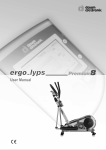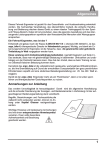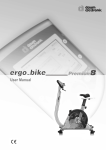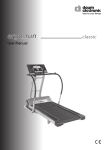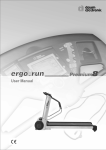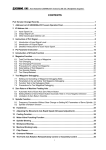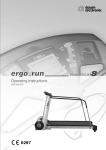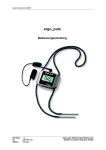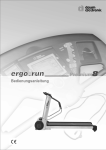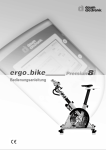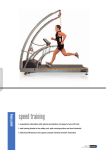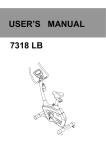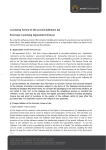Download Training - Sport
Transcript
8080 TRS3 User Manual Table of contents Please Note Setting Up Dashboard Dashboard windows Using the Menu and Language Selection Choosing the User Stand by mode System Settings User's data Device data Monitoring the Heart Rate Training Programs Programs overview How to create your own personal programs Training data Fitness mark Conconi Test Description Test programs Test protocols Description Coaching What is Coaching? Entering Personal Data Training with the Coaching program Taking the capacity test Display the training plan / training unit Running the training unit Training process Downgrading Loading scheme of the Coaching program Team Award The Relaxation function Transport and storage Accessories (sold separately) Specifications Glossary What to do, if...? Warranty conditions Menu Diagram Sample Diagrams, supplement to the Individual Program Assembling Maintenance 1 2 2 3 4 4 5 5 6 7 8 9 13 14 14 15 16 17 18 20 20 21 22 23 24 26 28 30 31 32 32 33 35 36 38 39 41 42 49 8080 TRS3 This ergometer is specially designed for health and endurance training. High quality manufacturing, a user friendly dashboard, ease of use and maintenance all contribute to make this appliance an ideal training device for sport and fitness purposes. Also note that the complete equipment and the wide performance range should appeal to sport or fitness conscious persons of every age group. Please note Read this user manual thoroughly before using the device. Please follow the recommendations about your health. You should undergo a general medical examination before you start a training program. You should interrupt immediately the training session if you fill uncomfortable, dizzy or in any way ill during a training session. Always start a training with a low load and then increase the load gradually. At the end of the training reduce the load. After the training you should execute a few stretching and gymnastics exercises to relax your muscles. Recommendations about the training location Install your training device on a level ground. The device may damage wooden floors. We therefore recommend the installation of a protective underlay on wooden floors. We also recommend not to in-stall the device on white or lightcoloured carpets or mats because they could be stained by the black colour of the device's feet. We recommend that the training location be properly aerated to provide enough fresh air, but nevertheless avoid draught. You can use this device in a temperature range from +10°C to +35°C. Safety notes Children should only use this device under supervision and they must be provided with a proper explanation of its operating principles. This device is not a toy. Please make sure the device is in working order. You should never train on a defective device. The device may only be used by one person at a time. You should wear appropriate clothing and shoes while training. The device may only be used if all the parts are firmly attached and no part is loose. You may only execute the repair operations described in this user manual. Other repair and service operations may only be carried out by qualified specialists. Do not press the buttons with the fingernails, always use the fingertips to avoid scratching the buttons. Avoid wetting the dashboard. If during a training session your dashboard is wetted by sweat you should wipe it with a soft cloth after training. The device surface should not come into contact with corrosive or strong chemicals. The maximum allowable user weight is 120kg. Daum electronic gmbh provides a 24 months warranty for the device for private use, and a three (3) months warranty for commercial use. The warranty is voided in the case of improper utilisation. 1 Setting Up When the device is switched On, the LCD screen displays a big “d” and the system plays a start-up tune. On / Off The On/Off switch is located on the rear of the device. watt After this the system displays the program last used. The manual program is displayed on the first start-up. The Dashboard 1. 2. 3. 4. 5. 6. 7. 8. 9. 10. 11. 12. 13. 14. 15. 16. 17. 18. 19. 20. menu 10. Heart rate display Dissipated energy and time display RPM display Speed and distance display Load in watt display Graphic screen Control button Heart rate sensor connector Relax sensor connector Menu key Info key Fitness key Function key Reset key (recessed) PC connector User display Memory card reader/writer Sliding switch: 1. card reader operation 2. ErgoWin u. dashboard update operation 3. Card reader update operation Connector dashboard cable Dashboard battery info 11. 17. 5. 2. 16. 4. 3. 9. 8. 7. 18. 15. fitness 12. 1. 6. 14. 20. 13. 19. 2 Dashboard Displays The graphic screen displays the programs. The load (in watt) is shown on the scale on the left side of the screen. The training time is shown on the lower axis. In heart rate controlled programs the system displays 100 beats per minute at the 200 watt position. In height profile programs the time axis shows the distance covered, while the watt axis shows the height profile. Note: the illustrations may be changed without notice! watt 250 The watt window shows the load in watt. The displayed watt value will blink to indicate reaching either the watt load limit of the device or the watt load limit of the user. It also shows the relax value with relaxation exercises. 13:08 3 You can individually set up which data you whish to view: clock, training time, speed, distance or dissipated energy (in kJoule). You can switch back and forth with a second display by pressing the control button. See page 5. The user window specifies the user number (1 to 4 or guest 0). The heart rate displays the heart rate. When only the upward pointing arrow is displayed in the middle, then this means that the heart rate is too low to ensure an effective training. Inversely, when only the downward pointing arrow is displayed then the heart rate is too high. If the arrow starts blinking then the load is too high and the user should moderate the training. OK Speed and distance window: this window shows the actual speed or the corresponding distance covered. Pressing the control button switches back and forth between these two values. See also page 5. The RPM display indicates the velocity in revolutions per minute. (+ = pedal faster, - = pedal slower). 3 + 128 0.0 0 Using the Menu and Language Selection Use the Menu key to call and leave the menu. Use the function key to move back one step in the menu. Press the info key to display information about the use of the menu. menu info fitness If you press the info key during a training (workout) session the system will display actual training and program data. Turn the control button to move up or down in the menu. Press the control button to open the selected option, e.g. language selection: Menu Settings Menu Training Training data Settings Information User Training Training data Settings Information User Back User data Device data Back watt Back watt watt 1. Press the menu key 2. Turn the control button to select “Settings” 3. Press the control button 4. Turn and press the control button to select “Device Data”. Language Device data Deutsch English Français Italiano Portuguese Date Time Contrast Language RPM-Adaptation Back Back watt watt 7. Press the Menu key to return to your training program, Press the function key to return to “Device Data”. 6. Turn and press the control button to select required language. Note: 2 languages are available for each software version. 5. Turn and press the control button to select “Language”. User display window Menu Menu Training Training data Settings Information User Training Training data Settings Information User Back Back watt User selection Guest User 1 User 2 User 3 User 4 Guest User 1 User 2 User 3 User 4 Back Back watt 1. Press the menu key 2. Turn the control button to select “User” 3. Press the control button User selection watt watt 4. Turn and press the control button to select a user from 1 to 4 or Guest. 5. The selected user is then indicated in display window 16. 6. Press the menu key to return to the start. The device will store the training data of four users. It is therefore important that each user selects his own “number” when training. Guest data are not stored. 16. User display window The following is an example of a possible user's number attribution scheme in a family: Mum Person 1 Dad Person 2 Daughter Person 3 4 Son Person 4 System Settings User's data menu menu Press the menu key Turn to select “Settings” Press control button Turn to select “User's data” Press control button If you want to change the user's data you should always note the presently selected user. This information will always be shown in the user window (16). (See Choosing the User p. 4) 16. User display window User data Physical data Limit values Coaching Delete Miscellaneous Back Turn and press the control button to enter and store your physical data Birth date Enter your birth date Gender Choose M (male) or F (female) to enter your gender. Height Enter you height in cm. Weight Enter your weight in kg. Fat content (%) Enter your body fat content (if known). watt User data Physical data Limit values Coaching Delete Miscellaneous Back watt User data Physical data Limit values Coaching Delete Miscellaneous Back watt User data Physical data Limit values Coaching Delete Miscellaneous Back You can also enter your own limit values. You would then be informed if one of these values is exceeded. You can select here the maximal load (between 25 and 400 watts). Watt If you choose e.g. 180W the load will not exceed this value, and the watt display will blink. When the actual heart rate exceeds the entered limit value Heart rate the system reduces automatically the applied load, and an audible alarm sounds. “OFF” means no heart rate limit active, “Auto” means heart rate corresponding to the age of the user applied. A signal melody plays when the time limit is exceeded. Training time A signal melody plays when the distance limit is exceeded. Distance A signal melody plays dissipated kJoule values reaches the entered value. Phys. kJoule You can also enter and save the Coaching data by turning and pressing the control button Enter your actual performance capacity. Evaluation Enter the number of times you want to train per week. Frequency Choose your target. Training type The minimum heart rate achieved during the last Coaching performance test. Min. heart rate The maximum heart rate achieved during the last Coaching performance test. Max. heart rate The performance achieved during the last Coaching performance test. Max. Performance The delete function will reset all the data of the selected user to the initial state. watt User data Physical data Limit values Coaching Delete Miscellaneous Back watt Start point Cool down Start-up Window 2 Window 4 Watt increase Watt decrease Heart rate adapting Choose start point “ON” if you want to start the program at the point of your choice. Choose a program to run at the end of a training session (see page 12) Choose the program that you wish to run after switching the device on. Choose the data to display in Window 2. Choose the data to display in Window 4. Set the watt increase rate (in seconds) for heart rate controlled programs. Set the watt decrease rate (in seconds) for heart rate controlled programs. Adapt the fixed heart rate programs to your own heart rate range 5 System Settings Device data menu menu Press key Device data Date Time Contrast Language Adjusting the RPM Back Turn to select “Settings” Press control button Turn to select “Device data” Press control button Date entry 1. Turn and press the control button to set the day. 2. Turn and press the control button to set the month. 3. Turn and press the control button to set the year. (DD/MM/YYYY). watt Device data Date Time Contrast Language Adjusting the RPM Back watt Device data Date Time Contrast Language Adjusting the RPM Back watt Device data Date Time Contrast Language Adjusting the RPM Back watt Device data Date Time Contrast Language Adjusting the RPM Back watt RPM Adjusting 100.0 % Back Setting the time 1. Turn and press the control button to set the hour. 2. Turn and press the control button to set the minute. 3. Turn and press the control button to set the seconds. (HH:MM:SS). Contrast You can choose a value for the contrast for the graphic screen from 10 to 25. The optimal value lies normally around 16. Language Choose the appropriate language: German, English, French, Italian, Portuguese, Finnish, Danish, Dutch. Note: Only 2 languages are available for any software edition. Adjusting the RPM (for the high performance sport domain) Material wear and deviations of mechanical settings may result in a discrepancy between the displayed RPM value and real pedalling speed achieved. We have therefore provided the software with a “RPM adjusting” function, which you can use to check the displayed RPM values and adjust it if needed. Pedal at constant speed (e.g. 60 RPM) for 1 minute (the clock in window No. 2 will show time progress) and count the pedal revolutions (measured value). The following formula gives the setting value: Measured value x 100% Displayed value (Window No. 3) watt “Set value” (turn) = Setting value (%) 6 Press control button Monitoring the Heart Rate Heart beats Please take serious care to watch your heart rate while training and not to exceed the limits! 200 190 180 170 160 150 140 130 120 110 100 90 80 Health Hazard! Beep Signal Ala rm z one Dan ger Example for a person 50 years old or heart rate limit of 170 100% Alarm Zone Heart rate above 170 zone 85% Danger Zone Heart rate 145 to 169 Aero OK bic zo ne 75% Heart rate 128 to 144 60% Aerobic Zone Heart rate 102 to 127 Display set to heart rate Heart rate 40 to 101 70 20 25 30 35 40 45 50 55 60 65 70 Age Whenever the actual heart rate exceeds that of the alarm zone and the heart rate limit for age / limit heart rate is set to active (see page 5) the system will give a beep signal and the load will be automatically reduced. Training in the aerobic heart rate zone The “ ” indicates training below the aerobic heart rate zone. “OK” indicates that you the user is training within the aerobic heart rate zone. The “ ” indicates training above the aerobic heart rate zone. A blinking display indicates reaching the alarm zone. Training in the aerobic zone will always be healthy and safe. This zone is located at 60% to 75% of the maximum heart rate or of the heart rate limit. You will always achieve your training target optimally if you train in the appropriate zone, whether your target is the improvement of your fitness level, the reduction of your body fat content or the development of muscular mass. For beginner: the widely accepted recommendation is to train at 55% to 65% of the maximum heart rate. This zone is very well suited for weight loss or for returning users after an extended interruption due to illness. A very high heart rate can be very dangerous! Heart rate measure using the ear clip Plug the connector on the right side of the dashboard, attach the clip on the other end of the cable to your ear. Display window 1 will then display your heart rate after a short delay. Heart rate measure using the chest band (optional accessory) Apply some water on the inner side of the band to the left and right side of the serration and then fasten it to your chest firmly to prevent it from sliding off and insuring the electrodes are in direct contact with the skin. If you have in the room many devices that may interfere with the signals of a wireless heart rate measuring device, then these devices must be located at a distance of at least 1.5m from the heart rate measuring device. If more than one wireless heart rate measuring systems are used in the same room then only one of these systems may be located close to the training device. Warning! If you have a heart pacemaker you should consult your physician to find out if you can safely use the chest band transmitter! 7 Training Note: Training with the ergo_memo-card1 is described in the user manual on the companion CD. Select a starting point When the starting point setting is set to “ON” (see also p. 5) you can choose the point at which the training will start with the built-in programs. Programs Please choose start point menu menu watt display sample Press key Programs Watt Heart rate Height profile Special Personal Prog Back Select “Training” (turn button) Press control button Select “programs” (turn button) Press control button press control button Choose “Starting point” (turn) watt display sample press control button Watt controlled programs: the applied load in independent of the speed. Heart rate controlled programs: when the heart rate exceeds the set value the load is decreased and vice versa. Height profiles: not available for this model. Special programs: strength and RPM programs. Personal programs: you can create your own programs. watt Watt Standard Cooldown Performance test Manual Standard programs: you can choose from 28 programs already stored in the machine. Cool-down: short programs for cool down after the actual training. Capacity test: use it to test how long you can go under an increasing load. Manual: you can here increase or decrease the load by turning the control button. Back watt Heart rate Built-in programs Manual Back watt Programs Watt Heart rate Height profile Special Personal Prog Back Zurück Built-in programs: with the built-in programs the heart rate is directly controlled. The set heart rate varies in the course of the program and thus the corresponding load. If the heart rate increases above the set value the load drops automatically; if the heart rate drops below the set value the load increases. Manual heart rate program: you decide at what heart rate in pulses per minute you want to train, and the device will adjust the load so that this value is maintained. Height profile programs: Not available for this model. watt Special Strength programs RPM Back Strength programs: these programs are based on 15 braking levels (1 to 15), and the effort there is a function of the pedalling speed. The load in watt corresponding to the braking level and speed is displayed in window No. 5. The load in watt corresponding to the braking level is determined from the actual speed multiplied by a factor specific to the program and rounded to 5 watt units. Constant RPM programs: this program was specially developed for joggers, as they want to run at their own personal jog frequency (speed). watt Personal prog. Watt Heart rate Speed Back Watt: you can create your own program for a load independent of the speed. Heart rate programs: you can here develop your own program that will individually control your heart rate during the course of the program. Speed: create a program controlled by the running speed. When your speed drops below the set value, the load will decrease, when your speed exceeds the set value the load will increase. watt 8 Training Programs overview You will find below a presentation of the available programs: Test programs Watt controlled Program 0 manual program (Watt) 1 WATT Program 1 Capacity test 25 Watt / WHO-Standard 32 Min. 0 10 20 30 40 2 Standard programs WATT 0 10 20 30 40 10 20 30 40 0 10 20 30 40 10 20 30 40 10 20 30 40 10 20 30 40 10 20 30 40 0 10 20 30 40 Program 4 Interval training “Medium” 35 Min. for women and men with little training experience Program 5 Interval training “High” 38 Min. for women and men with a good training experience Program 6 Pyramid “Low” 19 Min. for untrained women and men age up to 35 years Program 7 Pyramid “Mid” 43 Min. for trained users Program 8 Pyramid “High” 45 Min. for trained users 50 min 9 WATT Program 3 Interval training “Low” 33 Min. Light load training for women and men with little training experience 50 min 8 WATT 0 50 min 7 WATT 0 50 min 6 WATT 0 50 min 5 WATT 0 50 min 4 WATT Program 2 Capacity test 50 Watt / BAL-Standard 24 Min. for trained users 50 min 3 WATT 0 50 min Program 9 The Alps 23 Min. for trained users 50 min 9 Training 10 WATT 0 10 20 30 40 10 20 30 40 10 20 30 40 10 20 30 40 10 20 30 40 10 20 30 40 10 20 30 40 0 50 min 17 WATT 10 20 30 40 50 min 18 0 10 20 30 40 Program 11 Mount Everest 40 Min. for trained users Program 12 Active Profi Lady 25 Min. for untrained women up to 40 years of age Program 13 Active Sport Lady 22 Min. for untrained women up to 60 years of age Program 14 Beginners Training 1 18 Min. For young users up to 14 years of age Program 15 Beginners Training 2 23 Min. for untrained men up to 70 years of age 50 min 16 WATT 0 50 min 15 WATT 0 50 min 14 WATT 0 50 min 13 WATT 0 50 min 12 WATT 0 50 min 11 WATT 0 Program 10 Matterhorn 30 Min. for trained users 50 min Program 16 Body Watching 1 34 Min. for trained women up to 30 years of age Program 17 Body Watching 2 53 Min. for trained women up to 50 years of age The duration of this training of almost one hour requires strong will and will make you sweat! Program 18 Short 1 20 Min. suitable for squeezing a training session between two appointments 10 Training 19 Speed training 0 10 20 30 50 min 40 20 WATT 0 20 40 60 80 100 120 21 WATT 0 20 40 60 80 100 120 20 40 60 80 100 120 20 40 60 80 100 120 20 40 60 80 100 120 Endurance programs 20 40 60 80 100 120 20 40 60 80 100 120 20 40 60 80 100 120 140 min 140 min Program 24 Medium speed training 134 Min. Program 25 Heavy speed training 134 Min. 20 40 60 80 100 120 Program 26 Endurance load test “Performance sport” 80 Min. Program 27 Endurance load test “High performance sport” 80 Min. 140 min 28 WATT 0 140 min 27 WATT 0 140 min Program 23 Easy speed training 134 Min. 26 WATT 0 Program 22 Heavy excursion, 100 min Very demanding training for professional sport This program has extreme loading conditions! Please do not develop any exaggerated ambitions and do not overwork! 25 WATT 0 Program 21 Medium excursion, 84 min Very demanding training for high performance sport This program with high loads with continually varying loading. The loading conditions correspond to what is encountered in competitions. 24 WATT 0 140 min Program 20 Easy excursion, 70 min Demanding training for performance sport activity This program is suited to improve your endurance, to train for strength and endurance strength and to improve your tolerance to lactic acid. 23 WATT 0 140 min 22 WATT 0 140 min Program 19 Short 2rainieren 30 Min. for trained users, who want to check out their performance Program 28 Endurance load test “Professional sport” 80 Min. 140 min 11 Training 29 PULS Program 29 preventive, easy short program 20 Min. / max. 130 pulses / min. light load training for women and men with little training experience 200 150 Heart rate programs 100 50 0 10 20 30 40 50 60 70 min 30 PULS Program 30 Average Optimal Program 30 Min. / max. 130 pulses / min. light loading training for women and men with little training experience 200 150 100 50 0 10 20 30 40 50 60 70 min 31 PULS Program 31 long basic endurance program 60 Min. / max. 140 pulses / min. Endurance training for women and men with training experience 200 150 100 50 0 10 20 30 40 50 60 70 min Program 32 Basic endurance program with peak loads 50 Min. / max. 160 pulses / min. Demanding endurance training for women and men with training experience 32 PULS 200 150 100 50 0 10 20 30 40 50 60 70 min 33 PULS Program 33 Interval program basic endurance 35 Min. / max. 140 pulses / min. Endurance training for women and men with little training experience 200 150 100 50 0 10 20 30 40 50 60 70 min Program 34 Interval program (average load level) 60 Min. / max. 160 Pulses / min. Interval training in the basic zone for women and men with training experience Program 35 Interval program (average load level) 70 Min. / max. 170 Pulses / min. very demanding interval training in the higher heart pulse rate zone 34 PULS 200 150 100 50 0 10 20 30 40 50 60 70 min 35 PULS 200 150 100 50 0 10 20 30 40 50 60 70 min 36 PULS Program 36 Step test with 10 min load duration 60 Min. / max. 150 Pulses / min. Load test for the leisure and sport zone 200 150 100 50 0 10 20 30 40 50 60 70 min Program 37 Senior I, low heart pulse rate 25 Min. / max. 120 Pulses / min. This program is suited for pulse rate characteristics of senior users 37 PULS 200 150 100 50 0 10 20 30 40 50 60 70 min Program 38 Senior II, low heart rate 40 Min. / max. 130 Pulses / min. Demanding endurance training in the lower heart rate zone for active senior users 38 PULS 200 150 100 50 0 10 20 30 40 50 60 70 min Cool-Down Programs are the perfect way to end a training. Program 42 WATT 42 Easy cool-down 10 Min. For women and men with little training experience and following a very light training load 0 20 10 5 25 min 15 43 WATT 0 5 10 15 20 44 WATT 0 25 min 5 10 15 20 25 min Program 43 Medium cool-down 15 Min. For women and men with training experience a nd following an medium to heavy training load Program 45 Conconi 1 Program 46 Conconi 2 Program 47 Cardio program Program 48 RPM program Program 50 strength program Program 77 personal watt controlled program Program 78 personal heart rate controlled program Program 79 personal speed controlled program Program 44 Heavy cool-down 20 Min. For athletes with high performance training. The program allows an accelerated regeneration after the most heavy training loads. 12 Training How to create your own personal programs Personal prog. Every user can create one program of each of the following: watt, heart rate and speed controlled pro-gram. Users number 1 to 3 can create programs with a duration of up to 60 minutes, user number 4 can create programs with a duration of up to 240 minutes. Start by choosing the type of program you want to create. Make copies of the blank diagrams provided at the end of this user manual (page 42) and use them to design your programs. Watt Heart rate Speed Back watt Here is, for instance, the procedure to create a watt controlled program: Watt Select Watt. Select Modify and start “drawing”. Training Modify Turn the control button to the left/right to increase/decrease the height of the bar on the display until you set the bar to the proper height. Back watt Every drawn bar corresponds to a training duration of one minute. Display window No. 2 will show the minute at which you are now located. 1 min. watt When you set up this step (bar) to the required watt value press the control button. Repeat the same procedure with the following bars. … watt Repeat this procedure until you finish creating your program. Display example for entry step 1 watt When your program is finished press the function key and answer the question: “Erase the bars starting here?” Answer “Yes” or “No” (meaning: program ends either after the last value/bar entered or, if pre-sent, after the last existing value/bar) and select Training. The same procedure applies also for the modification of an existing personal program. A program designed on the blank diagram to look like the illustration to the left will appear on the screen as illustrated to the right. WATT 400 300 200 100 0 10 20 30 40 50 min watt For heart rate controlled programs you design a heart rate curve instead of a watt curve. If the heart rate measured during the actual training is below the curve the load will be raised and vice versa. For speed controlled programs you design a speed curve. When the actual speed during the training is below the curve the load is reduced and vice versa. 13 Training Training data Training data Actual Total Weight Fat content Coaching Back watt Display example for actual training data You review the training data of the selected user: - Actual: the training values of the last training - Total: the values of all the training units together - Weight: the distribution over a period of 60 days and of 1 year - Fat content: the distribution over a period of 60 days and of 1 year - Coaching: the values of the last capacity test and the actual coaching stand Actual Ø-kmh Max-kmh Time Distance 23.0 31.0 56.4 18.0 Back watt Note: if you don't run a program to its end you should press the menu key before switching the device off in order to save the training data. Other Training Data (turn) (see also the menu diagram pages 39/40) Fitness mark The device can carry out an evaluation your fitness. The measurement principle is based on the fact that the pulse rate falls faster within the first minute following a load period for healthy, well-trained users than for healthy, less trained users. If the user presses the Fitness key during a training session, the present training will be interrupted and the load will be lowered to 25 watts within a few seconds. The graphical screen will display the message “Fitness mark determination”. The drop in pulse rate within 60sec will be measured (see window no. 2) and the mark computed according to the following scheme and displayed: The fitness mark F1 is awarded for a pulse rate drop of more than 25.0% within 60 sec The fitness mark F2 is awarded for a pulse rate drop of 20.0% to 24.9% within 60 sec The fitness mark F3 is awarded for a pulse rate drop of 16.0% to 19.9% within 60 sec The fitness mark F4 is awarded for a pulse rate drop of 12.0% to 15.9% within 60 sec The fitness mark F5 is awarded for a pulse rate drop of 8.0% to 11.9% within 60 sec The fitness mark F6 is awarded when the pulse rate drop is less than 8% within 60 sec The mark of “F 0” is awarded if no usable result can be measured. After the evaluation process the training program resumes at the same position at which the fitness test was started. The load in Watt is raised within a few seconds to its value just before the evaluation and the training can be continued. A fitness evaluation is not possible after the training session is finished. Graphic window Fitness evaluation process A pulse measuring device (pulse sensor ear clip or the cardio sensor chest belt) must be connected and functional during the whole fitness evaluation process. The measuring process takes one minute and its progress is displayed. 1. Train at least 15 minutes in the OK-area. 2. 3. fitness Abbrechen Press the fitness key. Window No. 2 displays an “F”, and a timer from 1 to 60 seconds during the measurement process. 4. Continue pedalling “loosely” at the load of 25 Watt during the measurement process. 5. After one minute window no 2 displays the F mark and the system plays a short melody. Example for fitness mark 2 14 Conconi-Test Description The Conconi Test / E The Conconi test was originally developed for running to control the training intensity and to determine the performance ability. This test uses the fact that the heart pulse rate increases linearly with the load. This is true only up to a certain pulse rate and load. The pulse rate curve deviates from the linear if the load is further increased above this point (see fig. 3 page 18). This deviation point indicates the so-called anaerobic threshold according to researches by Conconi (for the Conconi test also known as the Conconi threshold). The anaerobic threshold is the point where the organism produces more lactic acid than it can eliminate. This means that, from this point, lactic acid starts to accumulate in the body and eventually leads to a load collapse. The threshold is used to determine the training domains and to evaluate the performance ability (you will find some practical hints about determining the training domains below). The main advantage of the Conconi test, as compared to e. g. the lactate performance test, is the small-ness of the necessary financial, technical and personal investment. At this point we should also mention that the Conconi test is controversial among many training professionals. It is widely used in Italy and Switzerland. Others have a critical approach toward the Conconi test for the following reasons: A maximum loading is necessary when undergoing the test. For this reason it is recommended to pass a medical examination before taking the test. The Conconi test should only be taken by healthy individuals. About 20% of all the tests do not show a deviation point. Sometimes the pulse rate increases linearly up to more than 190 pulses per minute. Nevertheless, the Conconi test permits an easy and accurate control of the training for many athletes, and an evaluation of their performance ability. Taking the Conconi test with the ergo_lyps: The Conconi test should in principle starts with an easy start-up program. One of the easier and shorter warm-up programs should be used here. The pulse rate should not exceed 130 pulses per minute during warm-up. Since the performance ability of users is widely spread, two special programs are provided for taking the Conconi test. Program 45 begins with a load of 60 watts and is intended for users with lesser training experience, while program 46 is intended for the more capable users. The load is increased by 20 watts every program step for both programs. You will find a test protocol on page 17. Write down the pulse rate values achieved and the corresponding load levels (in watt). You can then fill in the values for protocol 1 for the Conconi test (program 45, from 60 to 400 watts) in the upper part of the protocol. For the higher Conconi test corresponding to protocol 2 (program 46) fill in the heart rate values for load values of 120 to 700 watts maximum. The test should be terminated whenever the user feels he reached his maximum load capacity. An overload should absolutely be avoided! 15 Conconi-Test Test programs menu menu Press key Press Control button Select “Training” (turn) Press Control button Press Control button Select “Programs” (turn) Press Control button Select “Performance test” (turn) Select “Watt” (turn) Press Control button Select 45 or 46 (turn) Conconi-Test program 45 Watt 12,28 12,58 11,63 10,92 11,97 400 300 11,28 10,08 10,52 9,12 9,62 7,97 200 8,57 100 3,50 2,0 6,55 5,70 4,70 7,30 0 0 3 2 1 5 4 6 9 8 7 10 11 13 min 12 Conconi-Test program 46 Watt 11,13 400 11,57 10,17 10,67 9,10 300 9,65 7,88 8,52 200 2,72 1,47 100 5,68 4,80 3,82 7,22 6,48 0 0 1 2 3 4 5 6 7 8 16 9 10 11 12 13 14 15 16 min Conconi-Test Test protocols ergo_lyps 8080 TRS 3 TEST PROTOCOL / Conconi Test Name............................................. Date.......................... Time................... Heart pulse rate in beats / min PROTOCOL 1 / Program E 45 PROTOCOL 2 / Program E 46 (from 120 to 400 Watt) Power in Watt Heart rate at rest ....................... Notes about the test 60 80 100 120 140 160 180 200 220 240 260 280 300 320 340 360 380 400 Program E 45 ( 60 - 400 Watt ) 120 140 160 180 200 220 240 260 280 300 320 340 360 380 400 Program E 46 ( 120 - 400 Watt ) Heart pulse rates after 1 minute after 2 minute after 3 minute Conconi test program 45 (blank diagram) Heart rate in beats/min Heart rate 200 Maximum loading is necessary when running the Conconi test. Therefore we recommend undergoing a medical examination before taking the test. Only healthy individuals may take the Conconi test! There is no valid correspondence between the Conconi threshold and the lactate threshold. 150 100 50 0 0 100 200 400 300 17 Watt Conconi-Test Description Evaluating the Conconi test After the achieved heart rates have been properly recorded in the protocol, you can proceed with the graphical evaluation of the Conconi Test. Therefore construct a co-ordinate system as shown in figure 1 below. The horizontal axis (X axis) represents the performance in watt, starting with the lowest test value. For the Conconi test program 45 this value is, for instance, 60 watts. The vertical axis (Y axis) represents the heart pulse rate for every test step. In the example below the heart rate for the first test step (60 watts) is around 105 beats per minute, for the second step (80 watts) it is 120 beats per minute, etc. After all the heart pulse rate points have been represented in the co-ordinate system, proceed with joining the individual points to form the line representing the linear increasing portion of the curve. In the figure this is the straight line with the steep slope. The higher points (higher load steps) will generally lie underneath this line. These points can also be joined by a straight line as shown in the figure (this is the second line with the lesser slope). The intersection of these two lines is shown in fig 1 by an arrow. Heart pulse rate in beats / min 200 This intersection point is called the deflection point and corresponds to the anaerobic Conconi thresh-old. In fig. 1 this threshold is at 181 beats per minute. This heart rate is determined by drawing a straight line parallel to the lower axis (X axis) starting at the deflection point toward left. The point where this line intersects with the vertical Y axis (heart rate) is the point we want to determine (in our example 181 beats/min.). 180 160 140 120 100 80 60 100 140 180 260 220 300 340 380 Power in Watt Fig. 1: Graphical evaluation of the Conconi Test Heart rate in % Conconi threshold = 100 % The individual training domains can be determined using the heart rate at the deflection point (in our example 181 beats/min.) as shown in figure 2. The heart rate at the deflection point is assigned a value of 100%. 100 WSA 90 GA 2 80 GA 1 80% 70 Compensation 60 100 140 180 220 260 300 Performance in watt Fig. 2: Determining the training domains 18 Conconi-Test Compensation training The compensation domain lies underneath 70 percent. In our example this represents the region below 127 beats per minute. Training in this domain is for active recovery. GA 1 - Training The GA 1 domain lies between 70 and 80 percent. In our example this corresponds to 127 to 145 beats per minute. Training in this domain sets the foundation of the performance abilities. The most part of the training should occur in this domain (for endurance sports). GA 1 Training is the central element of biking in the preparation phase. Function Development of basic endurance as foundation for all the more intense training units. Training method The actual training follows the continuous training method with constant load and a pedalling speed of 80 to 110 RPM, duration of 2 to more than 5 hours. GA 2 - Training GA 2 - Training, more intensive biking, is used for achieving a higher loading for experienced athletes with a good basic endurance ability. Training method Warm-up and biking for 10 to 30 minutes, since GA 2 Training puts high loading on the musculature and circulation system. High heart rate limit of 80 to a maximum of 90 percent (in our example 145 to 163 beats/min ) The actual training follows the interval method (e. g. 8 x 4 min with 2 min. at no load) or alternatively the continuous method. CSE (competition specific endurance) Training Most intensive form of training for top athletics shortly before and during competition phase. The heart rate increases up to 100 % of the Conconi threshold (in our case 181 beats per minute). CSE training is run in the interval methods (e. g. 8 times 1 minute with 3 minutes at no load). Function Achieving maximum fitness. Getting used to very high lactic acid concentration in the musculature. Improved elimination of lactic acid. Training method Warm-up and biking for 10 to 30 minutes, since CSE Training puts high loading on the musculature and cardiovascular system. High heart rate limit up to 100% of the Conconi threshold. The actual training follows the interval method (e. g. 8 times 1 minute with 3 min. at no load). 19 Coaching Cardiovascular training What is Coaching? Fitness training Muscle build-up Weight / fat reduction The “Coaching” concept introduces an intelligent training program offering the user four different training objectives (see illustration above) to choose from. The ergo_bike will compute and monitor an optimal training plan based on the performance evaluation, available time, and an individual performance test. This training plan will be continually updated and adjusted through regular and automatic control of the training results to ensure an optimal training course and success. Warning! 1. The Coaching program was developed for users in good health condition. Therefore we urgently recommend that users undergo a thorough medical examination to determine their physical ability for sport activities before starting a training with the Coaching program. Should a user feel ill during a coaching training, he or she should seek medical advice about physical activities and continuing the training. 2. The user is required to enter the amount of time he or she can or want to train (the number of training units per week), and to evaluate his or her own fitness level. The user should not overestimate his capacity regarding the number of training units and their difficulty grade. In sport activity overworking does not help, while a thoughtful and controlled training plan leads generally faster and more efficiently to its objective. The same applies also to the self evaluation of the user physical performance capacities before the start of a Coaching plan. A user who evaluates his capacities at a lower level will achieve his training objectives safely and without overworking, even though in a longer period of time. 3. The user must take a capacity test at the start of the Coaching plan, and then once every 4 weeks. The computer uses this test to determine the load prescriptions (e.g. the maximum load in watt and the maximum heart rate during the training). This test is a full load test, and the user should only take it to the point where he can go without overworking or overloading himself. 4. When used properly, the coaching program will not turn users into high performance athletes. The goal of this program is to preserve your health and to increase your performance capacities, and to make you globally “fit”. Entering Personal Data The following basic prerequisites must be satisfied, and the important settings must be done on the dashboard before the coaching program can be started: 1. A user should train with the coaching program only with the pulse sensor always on (ear clip or even better with the cardio sensor chest belt) (see page 7). 2. The program must be assigned to a specific user identification number 1 to 4 (see page 4). 3. Since the program depends on many personal exact data, all the required data and alarm values must be entered before starting the program (see page 5) for the first time. Take into consideration that, as a special case for the Coaching program, the data about the training duration (time), the distance (km), and the kJoule burned need not be entered. These values are computed by the Coaching program. Any data entered for the alarm values for the training duration, the distance, and the kJoule burned will be ignored by the Coaching program or set to their default value (in this case 0). 20 Coaching 4. Personal performance evaluation The users must evaluate their personal performance capacities before starting a training with the Coaching program. The following section should help the users evaluate their own performance capacities: 0= Beginner: The user does not have any training experience or practices physical activity only occasionally and very irreg ularly. This applies also for users who are returning from a long training interruption (e.g. because of a wound or an illness). 1= Average: You do sport regularly. But you are mainly oriented toward recreational sport activities, less toward endurance sport. The training frequency is about 1 to 2 hours per week. 2= Advanced: You do regularly endurance sport (e.g. jogging, biking, etc.). The training frequency is about 2 to 4 hours per week. 3= Very well trained: You have an extensive training experience in endurance sport. Your physical performance and load capacity is above average. The training frequency is at least 3 hours per week, preferably in endurance sport. 5. Setting the training type menu menu Press key Select “Settings” (turn) Press Control Button Select “Personal data” (turn) Press Control button Press Control button Select “Coaching” (turn) With this setting the user sets his personal training target. Select “Training type” (turn) Once set, this setting can be changed only after confirming the safety message “Delete all data?”. If this message is confirmed by turning the control button to select “Yes” and pressing the control button, then all the programmed Coaching settings and stored training data for the actual training plan will be permanently erased! After this step, a new Coaching training can be started with the setting of another training objective. If you don't wish to erase the available data, and thus continue training with the actual training target, then you should select “No” by turning the control button and press it to confirm. Training type Cardiovascular Weight/fat Fitness Muscular development Back Training type WARNING: Delete all data? No Back No or yes turn press You can now begin training with the Coaching program. The Coaching program starts by determining the performance capacity of the user by mean of a capacity test. 21 Coaching Training with the Coaching program 1. Taking the capacity test (program 1) menu menu press menu key press control button select “Training” (turn) Select “Coaching” (turn) (the load increases by 25 watt every 2 minutes) 1 WATT After starting the ergometer the graphic screen displays the diagram of the capacity test. 400 300 200 100 0 10 20 30 40 50 min WHO Standard Capacity Test 25 watt (32 Min. / max 400 Watt) watt menu Do not exceed your personal load limit! Interrupt the training immediately if the load or effort becomes too heavy! press the “Menu” key to interrupt the test You should avoid extreme efforts on the day before the test and on the day of the test. Sleep sufficiently before the test. You should postpone the test if you feel ill (e.g. cold with fever). If you are un-sure, consult a physician. Please keep a pedalling speed of 40 to 60 RPM during the test. In order to take the capacity test you must have the physical capacity to run the test program at least up to 75 watts, in other words you must complete the first 4 minutes. Otherwise the test evaluation will read “not run” and any further training with the Coaching program will not be allowed! If this is the case, please retake the test and run it at least up to 75 watt. This load value is far below the capacity of the average user and according to medical research within the reach of every healthy adult user. If you have trouble reaching this load value then you should not continue with your Coaching training! In this case please consult a physician and take a thorough medical check, and talk with your doctor before you continue training with the ergometer. The “Coaching training” has been designed for use exclusively by healthy users! The evaluation test is complete at the latest when the user reaches the load of 400 watts after 32 minutes. Though, it is more realistic to expect that a user will not have the capacity to run the test to 400 watts (normal case!!) and will interrupt the test by pressing the “Menu” key because he lacks the strength or to avoid an overload. If you feel tired or exhausted (avoid overloading) please simply stop pedalling and confirm the end of the test by pressing the Menu-key! The Coaching program will automatically terminate the capacity test when you reach the higher heart rate limit corresponding to your age, gender, capacity, etc! Attention, the test will possibly be terminated too early if the higher heart rate limit setting value is too low. After the evaluation test is taken the system will display “OK” as a confirmation of the completed evaluation test. The program will take the actual capacity values into account to determine the personal training plan, and compares them with the test results of the successive capacity tests that must be taken at 4 weeks interval 22 Coaching Attention, a completed and accepted capacity test counts as the training activity for one calendar week. Thus the actual coaching program can only be continued on Monday of the following week. Obviously, each user is free to train with other programs during this waiting period, if his fitness condition allows it. Back 2. Display the training plan / training unit Running the training unit menu menu Press key Training plan Week 37100% Week 3833% Press Control button Press Control button Press Control button Select “Training” (turn) Back Training Unit 1 100% Unit 2 --% Unit 3 --% Select “Coaching” (turn) The evaluation test was run in the first training week (week 37), and that week is then completed to 100%. The weekly training for the actual week 38 has been completed to 33%. The system displays dashes “---” instead of the numbers for the calendar weeks that did not start yet. When the user confirms the selected training week the system displays the next screen “training” (training units). The screen shows that the first training unit (unit 1) has been completed to 100%. Since no training activity has yet been completed for the second training unit the system displays dashes “--” instead of numbers. The program is ready to run this training unit. Back When the user confirms the selected training unit, the system displays the message “Coaching Pr. xx/xx min, put on the heart rate sensor and start training” Press Control button When you start the training the system displays the diagram of the first program selected by the computer for the “training unit” e.g. watt The not completed training units (<100%) will be resumed at the minute at which the training were interrupted. The training unit not completed to 100% will always be concurrently selected. The display will show to the side the percentage of completion of the respective unit (e.g. 80%). The training can only proceed with the following unit (also selected) after the incomplete unit has been completed to 100%. The selection (highlight) of the incomplete unit is then removed. 23 e.g. Training Unit 1 100% Unit 2 80% Unit 3 --% Back Coaching 3. Training process The Coaching program can only help the user achieve his intended goal from training if the prescribed training units are run consciously. This should be the normal situation! In the case that a user must deviate from the training plan prescribed by the Coaching program because of illness, vacation or others reasons, the Coaching program offers possibilities to adjust the training. A training unit (TU) is not completely run: The system displays the message shown to the right the next time the Coaching function is called and before the display of the training units selectio n. It is confirmed by pressing the control button. The number of the incomplet e units will be displayed after the word “unit” instead of the “x”. This message will not appear after this unit is completed. Deviation from training plan . Continue incompletely run unit x press The user runs too few TUs during the calendar week The message to the right will be displayed at the start of the following week, after the training type is selected and before the training plan. It is confirmed by pressing the control button. This message will not be displayed as soon as . the missing training unit(s) is (are) completed. Deviation from training plan Catch-up on the missing units of last week! press Catching up incomplete training units In the case of training interruption, you have the possibility to downgrade the training plan using the control button. It is then possible to select a previous week (backward scrolling). Before the start of every training session, the computer runs a review of the training status and displays the results on the graphic display, with information about any eventual deviation from the training plan. This could be, for instance, missing training units from the previous week, which the computer determines immediately at the beginning of the training session in the following week, and signals with the message “Deviation from training plan” ---- “Catch up on the missing units of the past week!” (see illustration below). The missing units (in the example below week 39) of the previous week must be completed to 100% before the . training of the actual week 40 can start. Deviation from training plan Training plan Week 39 75% Week 40 --% Training plan Week 39 75% Week 40 --% Catch-up on the missing units of last week! press (Confirm) Back Turn to select week 39 Back In the situation described here, the previous week (e.g. week 39) will remain selected (highlighted) until the missing 25% training units are completed and week 39 is complete to 100%. Only then you will be allowed to start the training of the actual week 40. The highlighting (selection) of week 39 will be removed when the value reaches 100%. If the training is interrupted for a longer period (1 to X weeks) because of illness or vacations, it be-comes then impossible to catch up with the missing training units in a short period. For this situation, the Coaching program offers the possibility to downgrade a variable number of weeks. In the example below, the training was interrupted for 2 weeks (week 40 and 41), and 67% of the last training week, which is only completed to 33%. In this situation the program recommends downgrading to week 39. Then week 39 will also have to be completed to 100% before the training can resume with the actual week 42. 24 Coaching Downgrading the Coaching Program by 2 weeks Window no. 6 Deviation from training plan -- weeks are missing Training plan not complete! press (confirm) Deviation from training plan Downgrade your training plan at least to week 39! press (confirm) This message is displayed automatically Turn back to week No. X Week x e.g. Week 39 Training plan Week 39 75% Week 40 --% Week 41 --% Week 42 --% Back Confirm downgrading Downgrading sequence press (confirm) The lower target week of the downgrade can be set by mean of the control button. When a downgrade is confirmed, all the weeks downgraded, which were already completed, and all their training units will be reset to “0%”. Only the completed units of the week to which the downgrade is done (e.g. 75%) will be preserved. Also, now the actual date (e.g. week 42) will be used for the downgraded week. The illustration to the right (above) shows the display after a downgrade of 2 weeks to week 39. Both the downgraded week 39 and the actual week 42 are highlighted (selected). The selection of the downgraded week will be removed when it is completed 100%. Only then the training can resume with the actual week (e.g. week 42). The missing training units (25%) are completed later. Training plan Week 39 100% Week 40 - - % Week 41 - - % Week 42 - - % Back 25 Coaching 4. Downgrading Downgrading the Coaching program further than the minimum recommendation (downgrading further than prescribed) Deviation from training plan -- weeks are missing Training plan not complete! press (confirm) Deviation from training plan Downgrade your training plan at least to week 39! press (confirm) Training plan Week 39 75% Week 40 --% Week 41 --% Week 42 --% Back Turn back to week No. X e.g. week 38 This message is displayed automatically Downgrading sequence If, following an interruption, a downgrade is done to a week with partially completed training units (for instance only 25%), then the user will have to first complete the missing training units to 100%. This represents a non-negligible extra load for the user, particularly if weakened by an illness. Because the missing training units (e.g. 75%) must be completed in addition to the normal 100% training units of the actual week (week 42) during the actual training week (e.g. 42) (this would total to 175%). Therefore, we recommend giving up the last completed training units (e.g. the 25%), and to downgrade the training one more week (e.g. to week 38 / illustration to the right). Consequently, the training profile will be extended by 3 weeks. The illustration to the right shows that the training can resume with the actual week (42), without completing the training of week no. 39 that is interrupted at 25% when the training plan is downgraded by an extra week to week no. 38, which is completed to 100%. Training plan Week 38 100% Week 40 - - % Week 41 - - % Week 42 - - % Back Training plan Week 38 100% Week 40 - - % Week 41 - - % Week 42 100% Back Start the training unit (e.g. week 42) When the actual week (e.g. week 42) is completed to 100% the reference to the downgrade is removed (e.g. to week 38) and the system displays a normal training plan (see illustration to the right below). Training plan Week 42 100% Week 43 --% From now on, the training will proceed normally, i.e. as soon as week 42 is completed to 100%, the training plan proceeds with week 43. Back The user is on vacation and does not train for one or more complete weeks: The next time the coaching function is called the message shown here will be displayed after the training type is selected and before the training plan. The “x” in the message text will be replaced in the actual message by the number of the last calendar week whose completed part is > 0 %. You will find more recommendations about personal and individual downgrading on pages 27 and 28 in the case of illness, prolonged absence, many missed training sessions, etc. Deviation from training plan Deviation from training plan -- weeks are missing. Training plan not complete! Downgrade your training plan XX at least to week .... press (confirm) 26 press (confirm) Coaching Notes about downgrading in the case of training interruption: We advise beginners or the lesser active sportspersons, in the case they need to downgrade following a prolonged training interruption, to downgrade farther behind than the program suggests. The lost training is nevertheless very small and will be rapidly recovered. A well-trained user can close the interruption by doing a shorter downgrade and compensate the training. The training structure of the coaching is well thought and has a very cautious approach particularly towards health risks. It is very often the case that a very high training frequency is selected at the start of a Coaching plan, which cannot be held in real life. If you get the message “Deviation from training plan” many times, do not hesitate to reduce the training frequency. An essential aspect of the training on an ergometer is that it be done with a positive state of mind. In any case, you should avoid stress during the training! 1. Training interruption because of vacation and without sport activities during that period: 1a) 1 Week training interruption: Please continue with the last training week not completely done. 1b) 2 Weeks training interruption: Please downgrade by at least 3 weeks in the training plan. 1c) 3 and more weeks training interruption: Please downgrade by at least 4 weeks. 1d) In the case of a training interruption of more than 6 weeks: we advise the user, particularly beginners, to restart the Coaching plan from the beginning. 2. Training interruption because of illness. You should seek the advice of your physician before resuming the training. Many illnesses (e.g. infection with fever) will make you lose more physical capacity and endurance than a normal training interruption. Given the high number of possible illnesses we can only provide a very general overview. 2a) 1 week training interruption because of a common, light infection: Downgrade by about 3 to 4 weeks. We recommend consulting your physician before resuming the training. 2b) 2 weeks training interruption because of flu infection with fever: Downgrade to at least 4 weeks. We recommend consulting your physician before resuming the training. 2c) We urgently recommend you consult your physician about resuming the training in the case of any serious illness (e.g. viral flu, orthopaedic problems, wounds). 27 Coaching Loading scheme of the Coaching program? Trainings type = cardiovascular training: (sample with 3 training units per week) This type of training applies carefully its loading and leads to a healthy increase of the capacity of your cardiovascular system. The training units set by the Coaching program can be different from the samples cases presented here (e.g. depending on the personal performance evaluation, etc...). 1st Unit: 20 min with low heart pulse rate for cardio training. 2nd Unit: adjusted watt controlled built-in program no. 6 for 19 minutes. 3rd Unit: pulse controlled built-in program with individual pulse rate prescriptions. After about 24 weeks of training: 1st Unit: 45 min with low heart pulse rate for cardio training. 2nd Unit: pulse controlled built-in program with individual pulse rate prescriptions. 3rd Unit: adjusted watt controlled built-in program no. 4 for 35 minutes. Training type = weight reduction: (sample training with 4 training units per week) This training type applies a cautious loading at low heart rates. The training units have an extended training duration (up to 70 minutes). These units require endurance and motivation from you, but they help you achieve a stable weight reduction. Naturally, under the condition that you keep your daily calorie intake constant. Using this program, you can achieve a weight reduction of about 1.5 to 2 kg in the first 4 weeks, and then about 200 to 500 gr. per week in the following weeks. 1st unit: 30 min training with low heart pulse rate to burn fat. 2nd unit: adjusted watt controlled built-in program no. 12 for 25 minute. 3rd unit: heart rate controlled built-in program with individual heart rate prescriptions. 4th unit: heart rate controlled built-in program with individual heart rate prescriptions. After about 21 weeks of training 1st unit: 50 min training with low heart pulse rate to burn fat. 2nd unit: heart rate controlled built-in program with individual heart rate prescriptions. 3rd unit: adjusted watt controlled built-in program no. 17 for 53 minutes. 4th unit: heart rate controlled built-in program with individual heart rate prescriptions. Fitness training: (sample training with 5 training units per week) This training type helps you achieve endurance and fitness. It focuses on low intensity, somehow longer training units. 1st unit: adjusted watt controlled built-in program no. 3 for 33 minutes. 2nd unit: 30 min heart rate controlled built-in program with individual heart rate prescriptions. 3rd unit: adjusted watt controlled built-in program no. 12 for 25 minutes. 4th unit: 35 min training at the individual endurance heart rate. 5th Test for re-evaluation and determination of your personal heart rate at training. (This test will be carried out every 4 weeks, as was already mentioned.) After about 18 weeks of training: 1st unit: 50 min training at the individual endurance heart rate. 2nd unit: heart rate controlled built-in program with individual heart rate prescriptions. 3rd unit: adjusted watt controlled built-in program no. 4 for 35 minute. 4th unit: heart rate controlled built-in program with individual heart rate prescriptions. 5th unit: adjusted watt controlled built-in program no. 17 for 53 minute. 28 Coaching Muscle build-up (sample training for 6 training units per week) This training type leads to improving fitness and endurance. In addition to endurance training units, you will be required in this program to run training units with low pedalling speed (60 RPM). This will reliably increase your strength and endurance power, and support muscle build-up in a proportional way. 1st unit: adjusted watt controlled built-in program no. 3 for 33 minutes. 2nd unit: Strength program for 20 min for muscle build up. 3rd unit: 20 min heart rate controlled built-in program with individual heart rate prescriptions. 4th unit: Strength program for 25 min for muscle build up. 5th unit: adjusted watt controlled built-in program no. 7 for 43 minutes. 6th Test for re-evaluation and determination of your personal heart rate at training. After about 11 weeks of training: 1st unit: adjusted watt controlled built-in program no. 5 for 38 minutes. 2nd unit: Strength program for 40 min for muscle build up. 3rd unit: 35 min heart rate controlled built-in program with individual heart rate prescriptions. 4th unit: Strength program for 35 min for muscle build up 5th unit: heart rate controlled built-in program with individual heart rate prescriptions. 6th unit: adjusted watt controlled built-in program no. 8 for 45 minutes. You should keep a pedalling speed of 40 to 60 RPM with the strength program, which corresponds to the requirements of the coaching program. You can train with the Coaching program for a maximum of 80 weeks. If you want to further use the Coaching program you would have to delete all the data. End of Coaching! Delete all data? No Back watt If the date is not correctly set (e.g. after battery replacement or in the case of a weak battery) the system displays the following message: Attention Date OK? Delete all data? No Back watt Set the correct date. 29 Team Award Your perseverance will be rewarded Teamaward Take part in the Congratulation for completing 20,0000km! 120123456120 Back Team Award lyps Team Award awarding levels 2,000 km 400 km 4,000 km 8,000 km menu menu Press key Select “Information” (turn) Press Control button Press Control button Select “Team Award” (turn) Graphic screen If you send us the code number displayed in window no. 6, together with your name, your address, your email address, the serial number of your device (on the name plate), and the serial number of your dashboard (see “Menu”, “Information”, “Version Data”, “Serial Number”); we will send you an award for your performance. Give us a chance to surprise you! And you will be admitted in the “Hall of Fame”. Teamaward Congratulation for completing 20,0000km! 120123456120 Back You can enter the required information directly to our web page at www.daum-electronic.de, under the heading “Team Award” (the simplest possibility), or send us an email to “[email protected]”, or send us a fax to ++49 / (0) 911 753714, or write to us to daum electronic GmbH, Team Award department Flugplatzstr. 100, D-90768 Fürth 30 Confirmation code for the Team Award The Relaxation Function The relaxation function is a Biofeedback process that is carried out by measuring the electrical resistance of the skin. The measured values are indicated by means of optical and audio signals. Biofeedback is thus the translation into perceptible signals of physiological processes occurring in our body, which our senses can barely, or not at all, perceive. The relaxation function is a way of helping you relax and eliminate stress. You should use this option particularly after a physical endurance training. Connecting the relaxation sensor 1. Take the Velcro bands of the fingers' sensor out of the package and open them. 2. Place the open tape on one of your fingertip. Make sure there is good contact between the silver buttons and your skin. The wire from the tape should lead away from the back of your hand. Velcro tape Sensor button 3. Put down the side of the Velcro tape with the sensor button on your index finger and wrap the other side around it and press it firmly in place. 4. Wrap the other tape around your middle finger in the same fashion. 5. Plug the connector of the relaxation sensor into the “relax” input socket no. 9 on the dashboard. Relax sensor connector no. 9 Relaxing Relax program / process description menu menu Press menu key Select “Training” (turn) Press Control button Press Control button Select “Relax” (turn) Display window nr. 5 switches from Watt to Relax. A value is displayed, which starts at 199. 199 5. The displayed value drops gradually as you relax after training, and increases with the stress level. Watt relax 5. The Relax-value can drop all the way to almost zero. The user should therefore contribute to his/her relaxing and avoid any other stress. You can support this process by getting off the device and sit in a relaxed position, or lay down close to the training device and calm down. 0 The graphic screen supports the transparency of the relaxation function by displaying a curve representing the relaxation process. The displayed line shows the transition from the maximal value (199) to the minimum relax value (0). This process is visible in display window nr. 5. The same process is presented in a graphical form in display window nr. 6 (see illustration to the right). The actual relax level is indicated by a blinking bar in the display window. The complete relaxing process is divided into 25 levels. A short beep sound signals when each level is reached. The successive beeps are each lower in tonality. watt 31 5. Transport and storage Transport The rear standard feet are equipped with roller casters to ease moving the device. A handle is located in the left front longitudinal bar, you can pull this handle out after loosening the screw. Use this handle to lift and move the device (see illustration). Please take care to keep your back straight and to avoid injuries. Also move the device on flat floors to avoid damaging the bearings. Storage Store the device in dry and warm rooms, at a temperature range of 0 to +25°C. The humidity ratio should not exceed 70%. If you store the device for an extended period in a cold room you should let it warm up again before using it. 15 Accessories (sold separately) The wireless chest belt We recommend using a wireless not coded chest belt to achieve a better and more precise heart rate measurement. The corresponding receiver is already built into the device. ergo_memo-card 1 When it is inserted into the card reader in the dashboard, the training data are saved automatically on the ergo_memo-card1. The card can be loaded with individual training instructions and personal data of the user. These are then automatically read by the dashboard, making unnecessary to manually set the dashboard. Multifunction serial/USB Bluetooth-Adapter The serial/USB Bluetooth-Adapter is intended for wireless connection, Standard Bluetooth 2.0, of the daum training ergometer to a PC. Alternatively it can be used as a USB /serial adapter between the training device and the PC. Range about 10m (depending on the building conditions) Order No.: 9091024 You will find more accessories on our Internet site at: www.daum-electronic.de 32 Specifications 120 Computer-controlled, full electronic eddy current brake operating in the speed ranges shown in the diagram. Load range: 25 to 400 watt Speed range: 0 to 199 RPM Loading precision: Loading levels: 110 100 90 Rotational speed Braking system: +/- 10% In 5-Watt increments, manually adjustable 80 70 60 50 40 30 25 100 200 Power 300 400 Watt Drive: Single-stage, maintenance-free steel-ribbed belt drive in a spring supported drive unit. Flywheel: Machined Bio Feedback Function: Bio feedback based on the electrical resistance of the skin, measurement via finger electrodes, approx. 100 KOhm to 3 MOhm, self calibrating, display on LCD Panel in 255 levels and audible time controlled relaxing melody. Fitness level: Six fitness levels grading, displayed on LCD panel. Displays: 2 liquid crystal panels for heart rate, distance, speed, time, load in Watt, kJoule burned, pedal speed (RPM) and training time. 1 graphic display / 76 x 64 pixels / total of 4864 pixels. Heart rate measurement: On the ear, measuring range 50 to 199 pulses/min.; telemetric using Cardio sensor chest belt. (optional accessory). Limit values settings: Heart rate, distance, training time, kJoule, maximum load in watt Alarm signals: Acoustic and optical Weight: Approx. 75 kg Dimensions: W / H / L 55 cm x 155 cm x 105 cm Power supply: 230 V alternating current, 50 Hz, 55 W Safety class: 2 Technical safety recommendations: Compare the supply voltage on the nameplate on the housing with your local supply voltage prior to plugging the power cord to the power supply. Contact you dealer If the values are not the same. The device is completely disconnected from the power supply by pulling out the power cord, therefore it should always be plugged into an easily accessible socket. If the dashboard were subject to operational troubles due to static electricity turn the device OFF and then back ON again using the main switch. Areas of application: The device is suitable for therapeutic utilisation at home. (it is manufactured in compliance with DIN EN 957-1/9 Class A) Application class: class S, H, I It does not meet the requirements of medical diagnostic applications (clinical use). 33 Technical data EC Declaration of Conformity We declare under our sole responsibility that the product: ellipse ergometer model: ergo_lyps 8080 TRS 3 article number: 9056282 complies with all applicable requirements of the following prescriptions: 2004/108/EG EMC Electromagnetic Compatibility 2006/95/EG Low Voltage Directive Applied standards: EN 957-1:2005 EN 60601-1-2:2007 EN 60335-1:2007 daum electronic gmbh Flugplatzst. 100 D-90768 Fürth Tel.: ++49 (0)911 / 9 75 36-0 Fax: ++49 (0)911 / 9 75 36-96 Fürth, 18/12/2009 34 Glossary Aerobic zone. The training phase during which the load on the muscles is enough to keep them supplied with oxygen, but not enough to cause an overproduction of lactic acid (aching muscles). Aerobics also makes use of the aerobic zone. BMI. Body Mass Index Bio-Feedback. Acoustic and/or optical feedback on the metabolism and condition of the body. Coaching. Automatic training control oriented towards predefined training objectives. Distance. Distance covered in kilometres (km) Energy balance. The balance between energy intake and energy usage. There can only be a “balance” if intake and output are the same. For example, in Germany every person consumes on average 400 - 500 Kcal more than he or she can use. Joule ( Abrev.: J ); kilojoules (Abrev.: kJ) = 1000 Joule; Mega Joule (Abrev.: MJ) = 1000000 Joule. Energy unit named after the British physicist James Prescott Joule. (see Calorie) Calorie (cal). Energy measurement unit. Officially obsolete, but still in common use. It refers to thermal energy in particular. The conversion factor to the unit in use today (J): 1 cal = 4.1868 J, or the other way around 1 J = 0.2388 cal LED. Light Emitting Diode: when current is passed through a LED it emits light, either visible or invisible. It is used for indicator lamps or remote controls. Sore muscles. Painful phenomenon of the muscles tissues, occurring when the aerobic zone is exceeded leading to an overproduction of lactic acid. In order to avoid it, the ergo_bike compares measured data, input parameters and statistical values and displays the resulting aerobic zone status. Physiology. The science of life processes. Physical kilojoules (Abbr. phys-kJ) / physical Mega Joule (Abbr. phys-MJ). Represents only the mechanical work done on the ergometer; it is computed by mean of the following formula: Power [Watt] * Time [Sec] = Work [Joule]. Example100 Watt * 60s = 6000 Joule = 6 kJoule. This value does not cover the energy needed by the body to maintain its vital functions (e.g. respiration, blood circulation, metabolism). Realistic kilojoules (Abbr. real-kJ) realistic Mega Joule (Abbr. real-MJ). Using the data of the height, the weight, the age, and the sex, the system computes the approximate basic and total quantity of burned energy. The system will then display the approximate amount of kJoule actually burned during the training on the ergometer. RPM. Pedal speed in Revolutions per Minute. Self test. When switched on, the microprocessor checks the electronic circuits it uses to make sure everything functions properly. Virtual Reality. An illusion of reality generated by technical means that is influenced by external impulses or gives impulses to its surrounding. The device uses these possibilities through an optional accessory set. Watt (abbr. W). Unit of measure of the work done per unit time: 1 W = 1 J / s = 1 Nm / s = 1 VA WHO. World Health Organization Eddy current brake. Uses the fact that electric currents induced in a conductor by a fluctuating magnetic field produce joule-type energy which can be used for an electronically controlled brake. Time. Training time in minutes (for present training data) / in hours (for total training data) 35 ? What to do, if...? In the case of a failure ................... what to do if? All ergo_lyps undergo a detailed test before they are shipped. Should you, in spite of this, face a functional failure, the following recommendations should tell you what to do. General procedure to identify the cause of a failure The ergo_lyps consists essentially of two functional units the dashboard and the drive unit. The drive unit is located inside the device, before the crank/pulley. It contains the power supply, the eddy current brake and the related electronic circuits. The dashboard contains the electronic circuits used for system control, display and data processing. The dashboard and the drive unit communicate via a cable, which is routed through the dashboard support column, via a connector in the area of the receptacle of the dashboard support column. Should the assembled ergo_lyps fail to function, the defect would generally be found either on the dashboard, the drive unit or the cable connecting them. The most frequent cause of complaint turns out to be jamming the connecting cable during the assembly process of the ergo_lyps, or not properly plugging the cable connector. In the event of a failure, check carefully first if The cable connector found on the lower end of the dashboard support column is properly connected, and that the cable was not jammed or cut when the dashboard support column was mounted on the frame. To do this you need to disassemble the dashboard support column. The cable was not jammed or cut while mounting the dashboard on the support column, or if the cable connector to the circuit board inside the dashboard is loose. To do this you need to disassemble the dashboard. Fastening screws All the fastening screws must be tightened from time to time. We recommend tightening them at least after the first 50 km and then once every 500 km. Contacting your dealer or the service department of the ergo_lyps If the cause of the failure could not be identified, you should contact your dealer or the repair hotline of daum electronic gmbh (telephone number ++49 / (0) 911 / 97 536 - 0). We need the following information: 1. The device number (this number is on the plate on the lower frame bar at the front left side) 2. The dashboard version number (you can access this number under the “Menu”, “Information”, “Version Data”, "Serial Number” on the graphic display). 3. The proof of purchase and the device reference sheet. 4. ergo_lyps ergometers have a built-in failure diagnostic system, which signals device functionality using a red and a yellow LED. These LEDs are located on the small circuit board located on the drive unit inside the device. You can see this board from above through the metal frame (to the right side looking in the front direction). It is located on the front part of the drive unit before the big tensing spring. With the device switched on, the yellow LED should blink when pedalling or turning the crank wheel slowly, and blink faster when pedalling fast. With the device switched on, the red LED should light with high intensity when pedalling against a low load, and decrease in intensity as the load increases. Please inform us of the status of these LEDs for all complaints concerning “the device is not braking” or “the device is not braking properly.” This enables us to draw relatively concrete conclusions about the cause of the failure. If you wish to obtain more information on your device, please visit our service and repair hints web site on Internet (www.daum-electronic.de). You can also call our service and repair hotline (telephone number ++49 / (0) 911 / 97 536 - 0). 36 ? What to do, if...? RESET key Software Failure / Loss of Dashboard Control Recessed All computer controlled appliances have one undesirable characteristic in common that is that the normal software operation can sometime fail for generally unknown reasons. This situation is generally described by the expression “the system has frozen”. Should the dashboard operation fail and cannot be restored by means of normal keys operations, then the solution would be to press the recessed RESET key (No. 18) underneath the dashboard with a pointed tool (e.g. a pencil or ball pen). Noises ergo_lyps ergometers are equipped with quality ball bearings and a silent belt drive. However, it cannot be avoided that remaining noises be heard, which are in the range of LpA 52 dB (decibel). The squeaking or other disturbing noises generally originate from: - Wear of the V-belt - Wear of the slipping coupling - Wear of the bearings or also - Loosening of the crank arm fastening screws! - The bearings of the oscillating poles. - The fastening screws of the feet or dashboard support column! These screws must be tightened from time to time, but in any cases every 500 km!! Drive / Braking unit (eddy current brake) If a major failure is detected on the drive unit, it is possible to replace the complete unit. The braking unit, which consists of the flywheel, a transformer, a belt tensioning device and the mounting plate, is mounted with only three screws. You can order an exchange unit from daum electronic GmbH. The defective unit can then be relatively easily replaced with the new one, without requiring any adjustment, by your dealer or a bike mechanic. The flywheel of the ergo_lyps is equipped with two journal bearings. These bearings continue to run for a little while after you stop pedalling. Feeling a light drag on the foot rods is then normal. The journal bearings should be lubricated with Klüberplex BEM 34-132 grease every about 3000km (if the drag on the foot rods increases and becomes uncomfortable), depending on the load. 37 Warranty conditions § Warranty conditions Please consult your dealer/retailer in the case of a failure or trouble. The manufacturer daum electronic GmbH provides the warranty to your retailer according to the following conditions: 1. We guarantee that our products are free of manufacturing and/or material defects. 2. We will correct any problem pertaining to the above categories, with the exclusion of customer claims not related to those categories through upgrading services provided by us. We reserve the right, upon returning of the product in question, to exchange it with another product of the same type and value or, at our own discretion, to take it back against repayment of the amount paid by the customer (deducting overhead costs). 3. Our warranty covers a period of two years for parts and labour in the case of private utilisation of the product, and a period of three months, for parts and labour, in the case of commercial utilisation of the product, in both cases starting on the manufacturing date. We will fulfil this warranty service provided the customer will pay all freight and transport costs, including those for spare parts, and the cost of any packaging material we should possibly need to use. Returned devices will only be accepted if in the original packaging. (see illustration on page 44) Advance replacement of parts under warranty will be invoiced and delivered against payment (COD). The amount paid will be immediately refunded upon reception of the returned old part by us. 4. All other warranty claims, specially claims for the compensation of direct or indirect damages, or damage to a third party, or damages to other objects, as well as of damages due to failure, and of labour costs, are expressly excluded to the extend authorised by law. Should the repair fail within a reasonable delay, the customer has the right to demand a price reduction or the cancellation (modification) of the contract at his discretion. 5. We decline any responsibility for any wear occurring through normal utilisation. The warranty will be considered null and void if our instructions for mounting and utilising the device are not respected, or if the chemical products we recommend and deliver are not used, or if any modification was made to the device without our prior approval. 6. It is the customer's responsibility to check each one of our deliveries immediately upon reception. Any complaints about missing or defective parts must each be immediately transmitted in writing. 7. We do not guarantee that the delivered product will be suitable for the usage intended by our customer. Extended agreements need to be expressly confirmed in writing. 8. Any technical advice provided by us is formulated according to the best of our knowledge and in good faith, based on our own experience and testing. We do not assume any responsibility for this service, unless serious negligence can be proven on our part. If you wish to obtain more information on your device, you can visit our service and repair hints web site on Internet (www.daum-electronic.de).You can also call us on our repair hotline at daum electronic gmbh (telephone number ++49 / (0) 911 / 97 536 - 0). daum electronic gmbh, Fürth 38 Menu diagram 1.1.1.1. Standard 1.1.1.2. Cool-down 1.1.1. Watt 1.1.1.3. Capacity test menu 1.1.1.4. Manual 1.1. Programs 1.1.2.1. Built in programs 1.1.2. Heart rate 1.1.2.2. Manual 1.1.3. height profile *) 1.1.4.1. Strength programs 1.1.4. Special 1.1.4.2. RPM 1. Training 1.1.5.1. Watt 1.1.5. Personal programs 1.1.5.2. Heart rate 1.1.5.3. Speed 1.2. ergo_memo 1.3. Coaching 1.4. Relax 2.1.1. Ø km/h, max-km/h, time distance 2.1. Actual 2.1.2. Ø RPM, Ø watt, Ø heart rate, max. heart rate 2.1.3. phys-kJ, real kJ, BMI, Fit. Mark 2.2. Total 2.5.1. min heart rate 2.3.1. 60 days 2.3. Weight 2.5.2. max heart rate 2. Training data 2.3.2. 1 year 2.5.3. Max. performance 2.4.1. 60 days 2.4. Fat content 2.5.4. week 2.4.2. 1 year 2.5. Coaching 2.5.5. unit *) Not available for this model. 39 Menu diagram 3.1.1.1. Birth date 3.1.1.2. Gender 3.1.1. Physical data menu 3.1.1.3. Size 3.1.1.4. Weight 3.1. Personal data 3.1.1.5. Fat content 3. Settings 3.1.2. Limit values 3.1.2.1. Watt 3.1.2.2. Heart rate 3.1.2.3. Duration 3.1.2.4. Distance 3.1.2.5. Phys. kJoule 3.1.3. Coaching 3.1.3.1. Evaluation 3.1.4. Erase 3.1.3.2. Frequency 3.1.5. Miscellaneous 3.1.3.3. Training type 3.1.3.4. Min. heart rate 3.2.1. Date 3.1.3.5. Max. heart rate 3.2.2. Time 3.2. Device data 3.1.3.6. Max. performance 3.2.3. Contrast 4.1. Service 4. Information 3.2.4. Language 1) 3.1.5.1. Start point 3.1.5.2. Cool-down 4.2. Version 3.2.5. RPM Adjust 3.1.5.3. switching on 4.3. TeamAward 3.1.5.4. Window 2 5.1. Guest 3.1.5.5. Window 4 5.2. User No. 1 3.1.5.6. Watt increase 5. User selection 5.3. User No. 2 3.1.5.7. Wattdecrease 5.4. User No. 3 3.1.5.8. Heart rate adjustment 5.5. User No. 4 1) See page 6 for the language selection 40 Ohjelmien Sample Diagrams suunnittelu - supplement pohjat to the Individual Program Use copies of the following diagrams to design your watt controlled individual programs WATT 800 600 400 200 0 min 10 20 30 40 50 60 min 10 20 30 40 50 60 min 40 80 120 160 200 240 WATT 800 600 400 200 0 WATT 800 600 400 200 0 Use copies of the following diagrams to design your heart rate controlled individual programs. Heart rate 200 150 100 60 0 min 10 20 30 40 50 60 min 10 20 30 40 50 60 Heart rate 200 150 100 60 0 22 41 Sample Diagrams - supplement to the Individual Program Heart rate 200 150 100 60 0 min 40 80 120 160 200 240 Use copies of the following diagrams to design your speed controlled individual programs. km/h 80 60 40 20 0 min 10 20 30 40 50 60 min 10 20 30 40 50 60 min 40 80 120 160 200 240 km/h 80 60 40 20 0 km/h 80 60 40 20 0 42 Assembly and maintenance ergo_lyps Installation hints Miscellaneous Install the ergo_lyps on a level floor. The manufacturer will not be held responsible for any damage done to the floor. We thus recommend installing the device on a protective base. The ergo_lyps is not intended for use in damp rooms. Rust could develop, which would damage parts of the device and impair both the operating functions and the safety features. The ergo_lyps uses a mains voltage of 230 Volt, 50/60 Hz and has a power consumption of 55 Watt. The power supply you wish to use must fulfil these requirements! Any fault or defect on the device that have an impact on safety must be repaired immediately. Defective or broken parts must be replaced immediately (see spare parts list page 30). The device is not to be used until the repair is complete. top handle (with coating and cover plug) U shaped handle Handle (safety handle) (with rubber coating) Tension button (U shaped handle) Dashboard Power switch Oscillating pole right side (pre-installed) Tube of the dashboard housing Swivel joint cap (right and left) On / Off Drinking bottle (with holder) Dashboard support Swivel joint cover Sweat protection (with protective cover) Foot rods (right and left) Seal M8 locking screws Transparent plate sweat protection Step plates (right and left) (right and left) Crank and pulley Cover (right and left) Oscillating pole left side Swivel joints caps (internal and external) Handle (extractable) Swivel joint of the oscillating poles Front foot (transverse bar with adjustable feet) Base frame with (Steel frame with cover plates) Drive unit / eddy current brake Handle lock screw 43 Rear foot (transverse bar with caster feet) Package Contents The ergo_lyps can be assembled easily and swiftly by two persons. Small parts box The device: 1 x ergo_lyps base frame with drive unit 1 x dashboard stand with dashboard & U shaped handle 2 x feet set 2 x Oscillating poles / right and left 2 x Top handle with coating and caps 2 x Foot rods / right and left 2 x Step plates with corresponding screws 2 x Bearing shafts for the oscillating poles (right and left) 2 x Bearing shafts / crank lever (right and left) 1 x Drinking bottle with holder and screws Mounting hardware: N / 8x 4 x Recessed head screws M 8x50 (A) 4 x Spacer sleeves 12 Ø x 37.5 mm (B) 11 x Hexagonal head screws M8 x 20 (C) 7 x Spring washers DIN 127 - 8.1 (D) 4 x Washers DIN 9021 8.4 (E) 4 x Flat head screws M5 x 40 (F) 4 x Washers DIN 125 5.3 (G) 4 x Hexagonal nuts M5 (H) 3 x Dome nut f. hex. head screws M8 (J) 4 x Curved spring washers Et3159 (K) 2 x Screws 3.5 x 25 (L) 2 x Foot stopper (M) 8 x Swivel joint caps (N) Tools 1 x Wrench 8 mm 1 x Wrench 13/17 mm 1 x Allen wrench SW 6 ergo_lyps Package contents B / 4x A / 4x F / 4x L / 2x H / 4x G / 4x M / 2x 13 17 Accessories 1 x Pulse sensor Ear clip 1 x Relaxation sensor 1 x Software update cable 1 x User manual C / 11x 8 J / 3x D / 7x E / 4x K / 4x SW 6 Assembling the feet Insert the four recessed head screws with spacer sleeves (1) trough the two holes and tighten them firmly. A / 4x B / 4x SW 6 Foot with caster roller to the rear. 1 Please respect the proper positioning of the feet. 1 44 Installing the dashboard Connect the two cables X and Y by mean of the connector. Then raise the dashboard into position. Take care in doing so no to get the cables jammed or even severed. This assembly step is more easily executed with the help of a second person since the dashboard support column is heavy. C / 3x 13 D / 3x 17 Screw in the screws with the washers without tightening them for now. X Y Be careful to avoid jamming or separating the dashboard cable X/Y in the receptacle. Assembling the handles Pull together the two halves of the handle's extensions and insert the extension in the oscillating poles. Use a hammer, with a shock absorber (a piece of soft wood or plastic) between the handle and the hammer, to insert the handle into the oscillating pole until the pole's sleeve is even with the handle's extension. Repeat the procedure with the other handle. Be careful to hammer the handle in a perpendicular direction to the pole! It is mandatory to use a shock absorbing structure or a plastic or rubber hammer to hammer the handle's extension in place. You should lean the oscillating poles against a wall or any corner to keep them from slipping while hammering the handles in place. To further protect the poles and the wall you should place a soft material like e.g. a carpet or a piece of cloth between the pole and the wall. 45 Installing the oscillating poles 13 17 K / 2x Screw the hinge pins on the right and left sides of the dashboard support column and tighten them in place. E / 2x 13 C / 2x 17 Warning! Be careful to install the oscillating poles on the right side of the device. (see illustration). Attach the oscillating pole with the screw with washer and the curved spring washer without tightening them at this moment. Installing the foot rods (front) Attach the foot rods to the oscillating poles by means of the screws. Do not tighten the screws at this moment. D / 4x C / 4x 13 front rear right side front rear left side 46 17 Installing the foot rods (rear) Fit the curved spring washer on the hinge pin. K / 2x E / 4x C / 4x 13 Hinge pincrank lever Watch for thread direction!! Left - / L R Right - / R thread 17 Right foot rod Fit the hinge pins in the bearing carriers, respect the L/R marking on the front of the hinge pins. R L Fit the bearing carrier with the hinge pin on the crank lever. Both hinge pins must point to the front. Then attach them by means of a screw with washer. Do not tighten the screw at this moment. Installing the step plates The foot plates are attached with the two flat head screws. The side retaining wall must be located to the side of the device and the line of adjusting holes must point to the front. front Rear right front Rear left F / 4x H / 4x G / 4x 8 L / 2x Screw the foot stop in place. M / 2x 47 Installing the bottle holder Mount the bottle holder to the dashboard column using the supplied screws Installing the covers on the joints At this point in the assembly process it is possible to test the movement of the ellipse trainer by hand to evaluate the adjustment of the parts to one-another. If no visible defect and no unexpected friction or squeak noises are detected then you should firmly tighten all swivel joints and attachment screws, including those of the hinge pins (13mm or 17mm), and double check their seating position. N / 8x Once you are sure that all the screws are firmly tightened, you can put on the corresponding joint covers. J / 3x 13 One (1) cover on each side of the oscillating poles. 4 covers are used at the connection of the oscillating poles with the foot rods, that's 2 on each side. J / 3x One (1) on each side 48 17 Changing the position of the crank hinge pin The height of the foot rods can be adjusted, and thus the radius of the pedalling circle, by moving the hinge pin on the crank lever. 13 17 Remove the cover of the hinge pin position you wish to use. Remove the hinge pin by turning it backwards. Move the hinge pin to the new position and mount it by turning it to the front. Reinstall the covers on the unused positions. Stand foot If the ergo_lyps is installed on an uneven floor, use a screwdriver to adjust the compensation setting in the front feet to ensure a stable stand. Front Foot with compensation setting for the floor distance Adjusting the handlebars Loosen the tensing button on the dashboard to change the inclination angle of the handlebars. After you bring the handlebars to the required inclination retighten the tensing button back again. 49 Simple Maintenance and Service Activities Miscellaneous Every 500 km of cumulated running distance you should check whether all the screws are still firmly set. Tighten them back as needed. Care should be taken to remove sweat from the dashboard and the frame after every training session to protect the paint against rust. Rust damage caused by sweat is not covered by the warranty. Use a soft cloth wetted with water to clean the outer surface of the device. A light soap solution may also be used to wet the cloth. Procedure to replace the V-belt: Unplug the power cable from the main power supply before opening the device! Take particular care to avoid damaging the internal parts of your ergo_lyps while you are working. The manufacturer will not be liable for, any damages arising as a result of negligence while changing the V-belt! V-belts are wearable parts and as such are not covered by the warranty. The V-belt is located on the right side of the device 1. Remove the foot rod on the right side. Use the wrench (17mm) to loosen the hinge pin. (See page 5) 2. Remove the screws (9 units) fastening the side cover. 3. Remove the side cover. 4. The driving parts on the carrier plate / drive unit are now freely accessible. Press on the belt tension lever against the tension spring (9h) to release the V-belt tension, and then pull the belt from the pulley (9a). Follow the same steps (1 to 4) as described above in reverse sequence to install the new V-belt. 9a Before installing the new V-belt, you should clean the belt slipping surfaces of all driving parts, as well as the belt itself, with alcohol or cleaning petrol to remove the grease. 9c tension 9g lever 50 9p 9r spring 9h 9 Exchanging the Dashboard / Replacing the Battery Required tools: Phillips screwdriver / Blade 1 x 70 mm X X 1. Unplug the power cord! (For your personal safety and to protect the sensitive electronic parts inside the dashboard) A 2. The top part of the dashboard is secured to the bottom part by mean of 4 Phillips screws (A, B, C, D). Use an appropriate screwdriver to unscrew these screws from underneath the dashboard. (See the figure to the right) Please note that the screws C & D are located toward the outward border and are deeply recessed in the dashboard bottom part. Do not unscrew the nearby located screws (X)! B X C X D X X X 3. Then you can remove the top part of the dashboard very carefully. First open the dashboard housing by raising it from the higher side slightly and grasp (hold) with both hands underneath the top shell of the dashboard. Raise the higher part of the dashboard top shell further until the lower side separates from the dashboard support. Be careful to raise the top shell of the dashboard housing only until you feel a slight resistance from the cable that is connected from underneath, and until you can reach the connectors on the circuit board with your thumb + and index finger. X X X + 4. You must unplug the connector. Never pull on the cable to unplug it!! This would tear it off! Never pull the cable! It could tear off! 4. Be careful when pulling the connector in order to avoid damaging the circuit board and the electronic parts! Follow the same steps in reverse sequence to reassemble the dashboard top part 5. Plug the dashboard connector to the female connector of the corresponding colour until they lock in position. Then pull carefully the cable through the opening of the bottom part of the dashboard and the dashboard support and take care not to jam the cable when you reinstall the top part of the dashboard on the bottom part. 6. Screw the removed housing screws (A, B, C, D) from underneath the dashboard and tighten them until they attach to the upper part of the dashboard. 7. You can know plug the power cord, turn on the device and test its operation. Replacing the dashboard battery A button cell battery (CR 2032) is located on the underside of the dashboard circuit board. This battery must be replaced when the time and date keeping function fails. Problems when turning on the machine and display failures are also signs of an empty battery. Warning: The device must be switched OFF when replacing the battery. Afterward you must set the date and time. Unscrew and remove the 4 screws on the lower part of the dashboard. Then tilt the upper part of the dashboard up carefully. CAUTION! Failure to correctly replace the battery may create an explosion risk. Take care not to separate any cable connection. Never touch the electronic parts of the dashboard with your fingers! Charges of static electricity can destroy the sensitive parts. Press the clip holder outward with a pen to replace the battery, remove the battery and insert a new one with the plus symbol up. Reassemble the upper part of the dashboard carefully. Caution! Do not pinch any cable! + Notes about used button cell batteries - Keep batteries away from children, and do not swallow them! - Do not recharge empty batteries and do not throw them in fire. Please recycle used batteries by bringing them to the appropriate collect point, or return them to your dealer. 51 Spare Parts List Drive 3b 2 2b 2c 9g 2g 3h 3a 4b 1s 1m 1n 5b 1g 5 5a 8b 8 1c 1p 7 6a 6b 9c 9b Left side 9 8a 6b 4g 4h 4d 7a 4e right 14 15 13 No. Spare part 9d 6a 1a 4a 9k 5d 1d 4f ergo_lyps 8080 TRS pro When ordering parts, please include the device serial number with the part number. You will find the device serial number on the specifications plate located at the front on the lower frame cross bar on the left side. No. Spare part M80 56 600 00 38 950 A 06 50 949 00 37 155 12 10 801 12 10 803 00 37 351 07 05 186 03 00 035 07 50 090 00 38 170 00 38 175 00 21 412 00 37 150 2Dashboard housing including electronic parts 2bDashboard upper part 2cDashboard lower part 00 17 452 00 17 453 2gControl button 3Dashboard column 3aLocking lever / Handle positioning 3bU-shaped handle complete 3cHandle carrier complete (rear) 3dHandle clamp (front) 00 17 422 00 38 160 00 17 317 00 17 394 A 00 17 232 A 00 17 233 A 3gDrinking bottle holder with fastening screws 3hDrinking bottle 4Oscillating pole / right side with ball bearing 4aOscillating pole / left side with ball bearing 4bHandle set / oscillating poles extensions 4cPin bearing flange 01 00 050 01 00 045 00 38 105 00 38 100 M 80 50 800 A 00 37 120 ergo_lyps 8080 TRS pro Order nr. Order nr. 1ergo-lyps complete body 1aFrame 1bDecoration self sticking strips 1cCarrying handle 1dFrame cable 1eDashboard - frame connection cable 1fTransparent sweat protection cover 1gSealing / Sweat protection 1hMounting base for locking strip FTH 15 1kLocking strip 2.5 100 1mRight side cover 1nLeft side cover 1pFastening screws for the side cover 1sCover of the crank and pulley 10 9a 4d 4h 9m 11 5c 1f 3 left 9e 1s 1p 4c 4c swing feet 9f Right side 1b 4g-1 9n 9h 3d 3g 1e 4 12 3c 4dSet of swivel joint caps 4eFoot rod / left 4fFoot rod / right 4gStep plate left side (step plate right side /4g-1 order nr. 00 37 131) 4hPosition stopper 5Crank lever / left 5aCrank lever / right 5bShaft / Crank lever / left 5cShaft / Crank lever / right 5dCrank lever screw (washer / 00 05 571 ) 6Hardware bag 6aSpacer sleeve for fastening the foot 6bScrew for fastening the foot 7Complete front foot 7aFoot with adjustable height (front) 8Complete rear foot 8aFoot with roller caster (rear) 8bSet SF = “swing feet” upgrade kit 9Complete drive unit for the ergo_lyps 9aPulley with shaft and ball bearing 9bBall bearing 9cDriving belt (V-belt) 9dBrake magnet 9eFlywheel complete 9fBearing carrier with pulley shaft and ball bearing 9gBelt tensing unit complete 9hPulley tensing spring 9kRubber pad D 25 x 10 9mRubber pad M6*18 25x30 9nSliding joint 10Power transformer / 230 V, 50 - 60 Hz 11Power part / Version 2002 12Power switch 13Pulse sensor 14Relaxation sensor 15Cardio Sensor chest belt 52 00 37 510 00 38 120 00 38 125 00 37 130 / 00 37 131 00 37 345 00 38 150 A 00 38 155 A 00 37 100 00 37 105 00 30 571 00 37 461 00 09 535 00 21 850 M 80 90 197 00 17 418 M 80 90 198 00 17 419 00 17 635 M 80 50 000 M 80 50 200 A 00 09 316 A 00 31 070 M 80 50 050 M 80 50 060 M 80 50 070 M 80 50 080 00 09 233 00 07 320 00 07335 M 60 50 100 18 20 150 E 80 90 050 M 80 50 150 00 17 900 E 80 90 080 E 90 91 015 The daum training community! www.worldwidewebtraining.de The daum internet training offer! DAUM SERVER TRAINING OFFERS Physician Hospital Rehabilitation Trainer Fitness Studio Trainer Races The daum internet training server offers interpreted users and training specialists professional training and communication possibilities. Group trainings with up to 150 participants, image and voice communication with up to 10 participants favour motivation and team spirit. Research University - daum connects people by training! Web and email based registering Login on the web Entry and editing of personal data Reserving group training Detail view of group trainings Ranking lists Recording of the training data and parameters Evaluation of the training data Guest access with Live-Ticker Image and voice transmission Up to 150 participants per group training Integrates the platforms of other training providers ergo_win premium pro PC software PC training software for Daum bike, elliptic and treadmill ergometers of the classic and premium series Daum ergo_win premium pro connects training partners world wide. With a PC and via Internet it is now possible to train with friends, similarly minded persons, and training specialists using a web cam and a headset it is also possible to communicate with image and sound. Webcam Training Partner The Daum training server www.worldwidewebtraining.de connects interested users and training specialists. Sport enthusiasts can participate to international online races and online group rides. Training Profile with participants position Talking by walking - Multi-user capable Detailed personal setting possibilities Supports the ergo_memo card Participation to group training / network races Presenting your own group training / network races Supports Webcam / Headset Detailed training overview Detailed training evaluation with average and maximal values, heart rate / watt graphs and display training details with a precision of (up to) one second - Generate your own training programs - Controls four training devices simultaneously - Simultaneous monitoring of the four training devices - Superimposing of the training details of each training device - Visualising the limit values - Supports the Daum TRS Relax system - 4 picture and sound channels - User friendly interface - Training program manager - Training data manager - Memory card manager - Backup manager - Training program Import / Export And much more... Ready … … Set … … Go!!! I'm there!!! Hardware requirements: - Windows XP - DSL connection, USB connection - Pentium III-1 GHz or better - 200 MB free storage - 256 MB RAM - CD-ROM drive - 1024 x 768 Pixels monitor resolution with 24 bits colour depth Box Content: PC Software Order No. 9091026 Tel. ++49 / (0) 911 / 97 536 - 0 Fax. ++49 / (0) 911 / 75 37 14 www.daum-electronic.de ergo lyps 8080 trs 3 Order No. 90 56 282 daum electronic; daum electronic; Copying or using the contents of this manual, as a whole or in parts, is not authorised without the written permission of daum electronic GmbH. Stand: 26012010 Artikelnummer: 0630419e.0006 daum electronic gmbh Flugplatzstr. 100 D - 90768 Fürth


























































